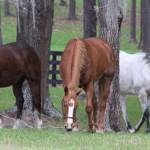Horse-Pasture Safety: Avoiding Atypical Myopathy

Imagine walking out to your pasture to find a few horses grazing happily, while two others are walking stiffly, producing dark urine, and breathing rapidly. Another one refuses to stand. This scenario plays out in the spring and fall, frequently presenting as outbreaks in certain geographical regions. The culprit: atypical myopathy.
“Atypical myopathy or seasonal pasture myopathy, which presents like a bout of tying-up, follows the ingestion of seeds or seedlings of certain trees of the Acer species, such as sycamores, that contain a chemical called hypoglycin A,” explained Laura Petroski-Rose, B.V.M.S., a veterinarian for Kentucky Equine Research.
One recent study* designed to alleviate horse owners’ worries regarding safe grazing strategies found that “mowing followed by collection of sycamore seedlings seems the current best option to avoid hypoglycin A (HGA) toxicity in horses grazing contaminated pasture.”
The veterinarians involved in the study also recommended that “pastures contaminated with sycamore material should not be used to produce processed hay or silage as both seedlings and seeds present in the bales still pose a risk of intoxication.”
“In addition to atypical myopathy, several other plant species are toxic to horses and should be avoided,” Petroski-Rose reminded.
Methods of helping horses avoid accidental ingestion of toxic plant-based feeds include:
- Avoid intentionally introducing those plants to your yard as ornamentals, no matter how pretty they are;
- Never feed hedge, bush, or plant trimmings to horses;
- Reach out to your local extension specialist to identify toxic plant species in your pasture;
- Use grazing muzzles and drylots in certain seasons; and
- Fence off sections of pasture that could be a cause for concern.
“Forage is the foundation of all equine diets. Owners that cannot procure appropriate forage for their horses can reach out to a Kentucky Equine Research nutrition advisor for assistance in formulating a diet using alternative forage sources,” advised Petroski-Rose.
*González-Medina, S., F. Montesso, Y.M. Chang, et al. Atypical myopathy-associated hypoglycin A toxin remains in sycamore seedlings despite mowing, herbicidal spraying or storage in hay and silage. Equine Veterinary Journal. In press.








